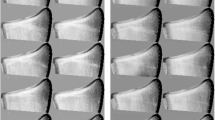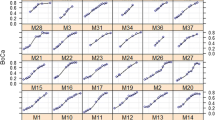Abstract
Though the Greulich and Pyle (GP) method is easy, inter-observer variability, differential maturation of hand bones influences ratings. The Tanner-Whitehouse (TW) method is more accurate, but cumbersome. A simpler method combining the above, such that it utilizes fewer bones without affecting accuracy, would be widely used and more applicable in clinical practice.
Objectives
1. Devising a simplified method utilizing three bones of the hand and wrist for bone age (BA) assessment. 2. Testing whether the 3 bone method gives comparable results to standard methods (GP,TW2,TW3) in Indian children.
Methods
Developmental stages and corresponding BA for radius, hamate, terminal phalanx (left middle finger) epiphyses combining stages from GP,TW3 atlases were described; BA were rated by two blinded observers. 3 bone method ratings were compared with the same dataset analyzed earlier using GP,TW2,TW3 (4 raters).
Results
Radiographs analysed:493 (Girls=226). Mean chronological age:9.4 ± 4.6 yrs, mean BA 3 bone:9.8 ± 4.8 yrs, GP:9.6 ± 4.8 yrs, TW3:9.3 ± 4.5 yrs, TW2:9.9 ± 5.0 yrs. The 3 bone method demonstrated no significant inter-observer variability (p = 0.3, mean difference = 0.02 ± 0.6 yrs); a strong positive correlation (p < 0.0001) with GP (r = 0.985), TW3 (r = 0.983) and TW2 (r = 0.982) was noted. Bland-Altman plots demonstrated good agreement; the root mean square errors between 3 bone and GP,TW3,TW2 ratings were 0.6,0.7,0.6 years; mean differences were 0.19,0.49,−0.14 years respectively. Greatest proportion of outliers (beyond ±1.96 SD of mean difference) was between 6 and 8 years age for difference in 3 bone and GP, and between 4–6 years for difference in 3 bone and TW3,TW2.
Conclusion
The 3 bone method has multiple advantages; it is easier, tackles differential maturation of wrist and hand bones, has good reproducibility, without compromising on accuracy rendering it suitable for office practice.


Similar content being viewed by others
References
M. Prokop-Piotrkowska, K. Marszałek-Dziuba, E. Moszczyńska, M. Szalecki, E. Jurkiewicz, Traditional and new methods of bone age assessment-an overview. J. Clin. Res Pediatr. Endocrinol. 13(3), 251–262 (2021)
Greulich W.W., Pyle S. Radiographic atlas of skeletal development of the hand and wrist. Stanford, Stanford University Press, 1959
A.F. Roche, C.G. Rohmann, N.Y. French, G.H. Dávila, Effect of training on replicability of assessments of skeletal maturity (Greulich-Pyle). Am. J. Roentgenol. Radium Ther. Nucl. Med 108(3), 511–515 (1970). https://doi.org/10.2214/ajr.108.3.511
C. Oza, A.V. Khadilkar, S. Mondkar, K. Gondhalekar, A. Ladkat, N. Shah et al. A comparison of bone age assessments using automated and manual methods in children of Indian ethnicity. Pediatr. Radio. 52(11), 2188–2196 (2022). https://doi.org/10.1007/s00247-022-05516-2
L. Franceschetti, V.G. Merelli, S. Corona, F. Magli, L. Maggioni, M. Cummaudo et al. Analysis of interrater reliability in age assessment of minors: how does expertise influence the evaluation? Int J. Leg. Med. 136(1), 279–285 (2022). https://doi.org/10.1007/s00414-021-02707-8
M. Loredana Marcovecchio, F. Chiarelli, Obesity and growth during childhood and puberty. World Rev. Nutr. Diet. 106, 135–141 (2013). https://doi.org/10.1159/000342545
K. Alshamrani, F. Messina, A.C. Offiah, Is the Greulich and Pyle atlas applicable to all ethnicities? A systematic review and meta-analysis. Eur. Radio. 29(6), 2910–2923 (2019). https://doi.org/10.1007/s00330-018-5792-5
C.T. Carpenter, E.L. Lester, Skeletal age determination in young children: analysis of three regions of the hand/wrist film. J. Pediatr. Orthop. 13(1), 76–79 (1993). https://doi.org/10.1097/01241398-199301000-00015
N. Cameron, The Tanner-Whitehouse II Skeletal Maturity Method: Rationale and Applicability. Clin. Pediatr. Endocrinol. 2(Suppl 1), 9–18 (1993)
Oza C., Khadilkar A.V., Goel P., Aeppli T., Mondkar S., Shah N., et al. Standardization of weightage assigned to different segments of the hand X-ray for assessment of bone age by the Greulich Pyle method. medRxiv. 2023 (Online); Available from: https://doi.org/10.1101/2023.06.02.23290917
N. Shah, V. Khadilkar, N. Lohiya, H.K. Prasad, P. Patil, K. Gondhalekar et al. Comparison of bone age assessments by gruelich-pyle, gilsanz-ratib, and tanner whitehouse methods in healthy Indian children. Indian J. Endocrinol. Metab. 25(3), 240–246 (2021). https://doi.org/10.4103/ijem.IJEM_826_20
V. Khadilkar, C. Oza, A. Khadilkar, Relationship between height age, bone age and chronological age in normal children in the context of nutritional and pubertal status. J. Pediatr. Endocrinol. Metab. 35(6), 767–775 (2022). https://doi.org/10.1515/jpem-2021-0698
V.K. Jaiswal, V. Khadilkar, A. Khadilkar, N. Lohiya, Stretched Penile Length and Testicular Size from Birth to 18 Years in Boys from Western Maharashtra. Indian J. Endocrinol. Metab. 23(1), 3–8 (2019). https://doi.org/10.4103/ijem.IJEM_242_18
V.V. Khadilkar, A.V. Khadilkar, A.S. Kinare, H.S. Tapasvi, S.S. Deshpande, G.B. Maskati, Ovarian and uterine ultrasonography in healthy girls between birth to 18 years. Indian Pediatr. 43(7), 625–630 (2006)
Tanner J.M., Healy M.J.R., Goldstein H., Cameron N, Assessment of skeletal maturity and prediction of adult height (TW3 method). 3rd ed. London: WB Saunder; 2001
M.P. Kumar, Muppavarapu Venu Madhav. Radiological assessment of hand skeleton ossification in children under Protein energy malnutrition (PEM) [Internet].2018;7(3):RO62-RO67. Available from: http://www.jcdr.net//back_issues.aspx?issn=0973-709x&year=2018&month=July&volume=7&issue=3&page=RO62-RO67&id=2421
J. Zhang, F. Lin, X. Ding, Maturation Disparity between Hand-Wrist Bones in a Chinese Sample of Normal Children: An Analysis Based on Automatic BoneXpert and Manual Greulich and Pyle Atlas Assessment. Korean J. Radio. 17(3), 435–442 (2016). https://doi.org/10.3348/kjr.2016.17.3.435
A.E. Flatt, The troubles with pinkies. Proc (Bayl Univ Med Cent) 18(4), 311–344 (2005). https://doi.org/10.1080/08998280.2005.11928094
R.K. Bull, P.D. Edwards, P.M. Kemp, S. Fry, I.A. Hughes, Bone age assessment: A large scale comparison of the Greulich and Pyle, and Tanner and Whitehouse (TW2) methods. Arch. Dis. Child 81(2), 172–173 (1999). https://doi.org/10.1136/adc.81.2.172
J. Singh, H.V. Knapp, J.G. Arnold, M. Demissie, Hydrologic modeling of the Iroquois River watershed using HSPF and SWAT. J. Am. Water Resour. Assoc. 41(2), 343–360 (2005). https://doi.org/10.1111/j.1752-1688.2005.tb03740.x
C. Gao, Q. Qian, Y. Li, X. Xing, X. He, M. Lin et al. A comparative study of three bone age assessment methods on Chinese preschool-aged children. Front Pediatr. 10, 976565 (2022). https://doi.org/10.3389/fped.2022.976565
M.M.C. Lee, Maturation disparity between hand‐wrist bones in Hong Kong Chinese children. Am. J. Phys. Anthropol. 34(3), 385–395 (1971). https://doi.org/10.1002/ajpa.1330340308
D. Zabet, C. Rérolle, J. Pucheux, N. Telmon, P. Saint-Martin, Can the Greulich and Pyle method be used on French contemporary individuals? Int J. Leg. Med. 129(1), 171–177 (2015). https://doi.org/10.1007/s00414-014-1028-7
J.R. Kim, Y.S. Lee, J. Yu, Assessment of bone age in prepubertal healthy Korean children: comparison among the Korean standard bone age chart, Greulich-Pyle method, and Tanner-Whitehouse method. Korean J. Radio. 16(1), 201–205 (2015). https://doi.org/10.3348/kjr.2015.16.1.201
P. Patel, A. Chaudhary, B. Dudhia, P. Bhatia, Y. Jani, N. Soni, Accuracy of two dental and one skeletal age estimation methods in 6-16 year old Gujarati children. J. Forensic Dent. Sci. 7(1), 18–27 (2015). https://doi.org/10.4103/0975-1475.150298
Author information
Authors and Affiliations
Contributions
All authors played a role in the conceptualization, planning, execution, bone age rating, analysis and writing of the manuscript and they all agree and accept responsibility for the contents of the manuscript submitted to the journal.
Corresponding author
Ethics declarations
Conflict of interest
The authors declare no competing interests.
Consent for publication
The participants have consented to use their data for the purpose of publication.
Consent to participate
Informed consent/assent was obtained from all participants/ their parents for the study.
Ethical approval
This study was performed in line with the principles of the Declaration of Helsinki. Deidentified radiographs of children aged 0–18 years from a previous dataset were used. The original study was approved by the institutional ethics committee (original approval was dated 7 Aug 2019) and written informed consent/assent was given by all participants/parents. As we used deidentified data in the current study, a waiver was granted by the ethics committee.
Additional information
Publisher’s note Springer Nature remains neutral with regard to jurisdictional claims in published maps and institutional affiliations.
Rights and permissions
Springer Nature or its licensor (e.g. a society or other partner) holds exclusive rights to this article under a publishing agreement with the author(s) or other rightsholder(s); author self-archiving of the accepted manuscript version of this article is solely governed by the terms of such publishing agreement and applicable law.
About this article
Cite this article
Khadilkar, V., Mondkar, S., Desai, K. et al. Development of a simplified new method of bone age estimation using three bones of the hand and wrist. Endocrine (2024). https://doi.org/10.1007/s12020-024-03684-9
Received:
Accepted:
Published:
DOI: https://doi.org/10.1007/s12020-024-03684-9




